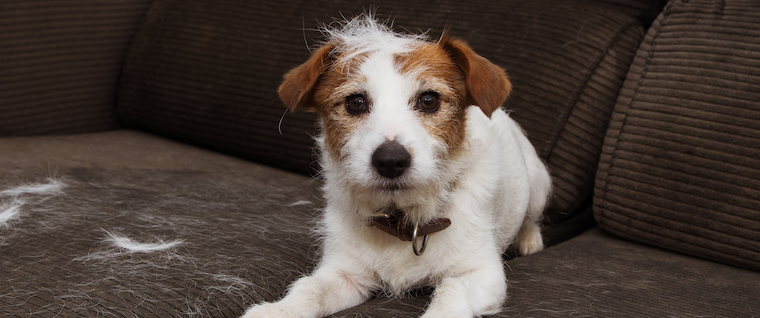Many dog owners can predict the weather more by the state of their floors and furniture than by the temps outside: when the dog hair starts to pile up, it must be the start of warmer seasons. Other homeowners fight the shedding all year long. So what’s causing this mess, and how can we make it better for us (and our dogs)?
Why do dogs shed?
Shedding is normal for almost all dogs. They shed the hair that is old and no longer growing as part of the normal hair-growth process. New hairs keep oil near the skin and protect the dog from weather and the environment. Many dogs, especially those with undercoats, shed hair in spring (and sometimes fall) to prepare for a change in temperature (protecting their skin and adjusting to being hotter or colder).
That said, if your dog begins to shed more than usual, it could be a sign of a skin infection, anxiety issue, nutrition problems, or pests, so talk to a veterinarian if you’re concerned about excessive shedding.
Which types of dogs shed?
Most dogs shed at least a little, but some breeds shed a lot more than others. Breeds known for significant shedding include Border Collies, Pugs, Labrador Retrievers, Beagles and German Shepherds. Specifically, breeds with dual coats/undercoats tend to shed a lot as they “blow out” their coats before the weather gets warm. These include Chow Chows, Samoyeds, Sheepdogs, and other breeds originally from Northern climates.
Owners of dual-coated dogs can expect a heavy shed this time of year, while owners of dogs like Dalmatians and Labradors will see consistent shedding throughout the year. Dogs that spend more time outdoors are likely to shed more than primarily indoor dogs.
How can I help my dog shed less?
There’s nothing to do that will completely prevent your dog from shedding. The best way to keep your dog comfortable and your floors and furniture clean is to brush your dog regularly. Ask your groomer to recommend a brush that specifically works for your dog’s type of hair. Washing your dog with dog-friendly shampoo before brushing can also help remove trapped hair and prevent tangles.
Owners with dual-coated dogs may want a product like the Furminator to help “de-shed” their dogs. These coarse metal brushes help remove the rough undercoat hairs before your dog “blows out.”
Owners of sleeker-haired dogs like Labradors and Dachsunds may prefer a dog glove brush to gently remove those tiny hairs before they end up all over your coach.
Finally, some dog owners may turn to shaving their dogs (or getting a “clip down”) to remove the bulk of their hair. Clip downs can help cool very thick-haired dogs and relieve potential issues for dogs with matted fur or those who regularly get wet. To ensure your dog won’t get sunburned or be vulnerable to skin threats, leave some hair near the skin. If you don’t want to change the look or feel of your dog, consider asking your groomer for a de-shedding treatment instead of a summer shave.
Dog shedding is a part of dog ownership. Embrace brushing as another way to connect with your dog, and perhaps you’ll be a little more forgiving of a few hairs on the couch this year.
And remember, if you’re concerned about excessing shedding, contact the vets at Animal Clinic of Woodruff for an appointment.




